A longboard deck is the long, flat board you stand on when skateboarding. Longboard decks typically fall between 33" and 60". Their length and their unique shape distinguish them from traditional skateboards. Longboards are a great skateboard option for cruising, carving, freeriding, downhill, and slalom. They are also is a dependable choice for commuting if you need to get from A to B quickly.

There are several things that go into choosing a longboard deck. The length, width, shape, and material you choose should match the style of longboarding you want to do. We've broken down the most important factors to help you figure it out.
Because longboards aren't usually used for tricks (at least not to the degree shortboards are), the life of most longboard decks is fairly long. Avoiding longboarding in the rain and make sure you store your board in a dry area to prolong its life even further. If your skate deck does show signs of splitting or the wheels feel uneven, either from riding conditions or accidents, it's time to invest in a new board.
Warehouse Skateboards offers a huge selection of longboard decks in a variety of shapes, sizes, weights, colors, and patterns--feel free to browse our inventory and figure out what skateboard deck is right for you.
Choosing a longboard deck material
Longboards decks can be made from a variety of materials. We've listed a few of the most popular kinds here.
Maple
Maple is the most common material for skateboard decks. This type of wood is very sturdy and enduring. It remains solid and reliable over time, even if you're skateboarding hard. View our collection of Maple Longboard Skateboards.
Bamboo
Bamboo skateboards are increasing in popularity. Bamboo is a bit more flexible than maple and is wonderfully lightweight, making it ideal for both riding and carrying. Bamboo boards are perfect for carving, cruising the streets, and transportation. View our collection of Bamboo Longboard Skateboards.
Carbon Fiber
Carbon fiber is the most expensive material for a longboard skateboard. With a foam core to lighten the weight, carbon fiber boards are designed to help you push off the start line faster and move effortlessly around turns and slides. Typically considered pro skateboards, you will see pro skaters riding carbon fiber. View our collection of Carbon Fiber Skateboards.
Choosing a longboard deck shape
There are many different shapes of longboard deck, and each shape is made for a different style of longboarding. Below is a general guide to help distinguish the different longboard types and their uses.

Cruisers
This style of longboard is the most popular. Cruisers are maneuverable and relatively fast, and the large deck size allows for greater weight distribution. This is a reliable and straightforward rig. View our collection of Cruiser Longboard Skateboards.

Downhill
Downhill racing is not for beginners. You can reach extremely high speeds when boarding, and wipeouts are "the normal." Downhill skateboards tend to be flat and have long wheelbases to provide for greater stability. When selecting a downhill board, it is important to choose a deck that is stable at high speeds and doesn't offer a lot of flex. As a reminder, it is vital that you wear protective gear when doing downhill racing. Not just a skateboard helmet, but protective skateboard pads as well. View our collection of Downhill Longboard Skateboards.
Features of longboard decks
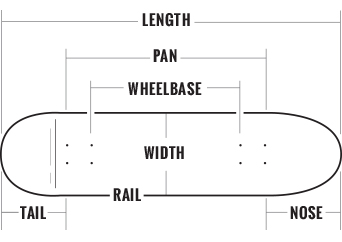
Longboard decks vary in size but most are between 7"-10" wide, and are made of seven-ply wood, bamboo, resin, carbon fiber, or plastic. Deciding which skateboard deck is best for you depends on what you will be skating and, of course, your personal brand preference. Below are some factors to consider when buying your longboard deck.
Width
Choose your longboard deck according to the width, not length. The average width of a skateboard deck is 7.5"- 8.25". The right width depends on your size and skateboarding style. If you buy a deck that is too wide for your height and shoe size, you will need to exert more power, which can make skateboarding and trick riding difficult. If you choose a board that is too narrow for your height and shoe size, you'll have trouble balancing and won't feel stable. Generally, teen and adult riders will want at least a 7.5" width. Larger skateboarders and those skating ramps and vert ramps should go with a wider deck, and street skaters usually need a smaller deck.
Length
Deck length is the distance from the tip of the nose to the tip of the tail. Longboards are, by definition, longer than 32 inches. However, width and wheelbase should be top considerations when building your skateboard, rather than length.
Wheelbase
The wheelbase is the distance between your board's inner mounting holes. The distance between these mounting holes determines how far apart your front and back wheels will be. Manufacturers determine wheelbase by where they drill the truck mounting holes on the deck. The average wheelbase is 13"-15". Although many decks only feature one set of holes, some skateboards have multiple mounting holes for trucks (or "wheelbase options"). Adjusting wheelbase can dramatically affect how the board performs. Your experience level will indicate the right wheelbase for you.
Nose and Tail
The nose is the "front" of your skateboard and the tail is the "back." Which end is which can be hard to differentiate, but most decks provide you with graphics to tell the two apart. Many skateboard decks have a bigger kick on the nose and mellower kick on the tail.
Mounting Holes
Mounting holes are pre-drilled holes where the longboard trucks are attached. Arranged as two sets of four holes; one set is near the nose, the other near the tail.
Ply
Ply is the thin levels of wood that are tightly pressed together to make the longboard deck. Rather than making a deck from one solid piece of wood, most manufacturers layer the wood in a cross-grain pattern to create a supremely strong board. The typical skateboard is seven-ply, and most boards aren't over nine-ply.
Concave
Concave is the curve of the wood between the deck's nose and tail. Concave allows a more controlled ride and a stronger skateboard. Read our concave guide below for more information about different concave shapes.
EFP
EFP is short for Effective Foot Platform. Unlike wheelbase, which measures only distance, EFP describes the area on the topside of the deck that riders stand on to control the board. EFP indicates the part of the deck between the front and rear trucks. You can think of EFP the space of a skateboard deck that isn't the nose or tail.
Rails
Rails are the edges along the length of your board, and their shape can make a difference in how your board rides. Rounded rails are common for longboards. Sharp rails have a blunt edge, which can keep your shoes securely in place. Gas pedal rails (or GPs) are a specialized rail shape where areas of the rails have been cut to a beveled edge. GPs subtract the rail's sharpness, and decrease the concave. Gas pedals give you better control and comfort when doing slides. What your rails can do also depends on the concave of the board.
Top Selling Decks
Skateboard concave shapes
Concave is a major factor in longboard performance. Longboard manufacturers are always experimenting with new concave shapes to accommodate new types of skating. Most concave shapes allow riders more foothold than a flat skateboard, which can take sliding, drifting, and turning to the next level. Here are a few of the main types of deck concave found in skateboards and longboards.
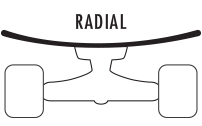 |
Radial Concave This concave shape may look familiar to you. The subtle U-shaped curve is the most common deck shape, though some boards have a deeper curve than others. This type of concave allows your feet better grip, which can be useful in nearly all styles of skateboarding. |
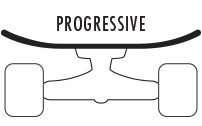 |
Progressive This shape is a similar but more dramatic version of the radial concave. The steep wall on the rail combined with the wider base allows more secure footing and a more locked-in feel. |
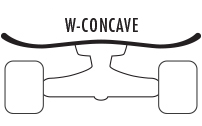 |
W-Concave The W-shape does not extend the entire length of the deck, just the area towards the tail. The extra curve in the centerline allows you to shift more energy from your heel to your toe. The result is a highly precise, responsive board that can turn quickly. |
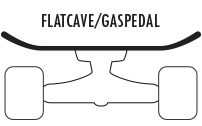 |
Tub Tub concave (also called flat-cave) is similar to a radial board, but instead of a gentle curve, the rails extend at a sharp angle from the deck. Tub boards keep your feet flatter, which makes for a mellower ride, but the sharp rails can still provide sudden shifts in energy. |
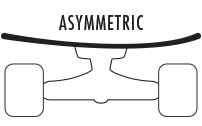 |
Asymmetrical Asymmetrical concave is when the skate deck rails rise at different angles. This allows riders more power in their heels for turns. |
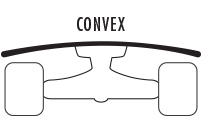 |
Convex Convex boards feature an upwards-arching deck. They are uncommon, though some slalom and downhill skateboarders love the more natural foot placement convex boards provide. |
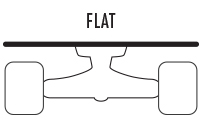 |
Flat Skateboard decks with no concave are rare, with the exception of reissue old school decks. Some cutout and dropdown longboards also feature flat decks. They allow lots of space for your feet, and allow room for boardwalking and other showy tricks. |
Camber & Rocker

The lengthwise curve of your skateboard deck also plays a role in how the deck feels and what kind of skateboarding you can do on it. Longboard decks with a raised middle are known as camber longboards, and those with dropped middles are called rocker longboards. The angle of camber and rocker is typically mellow, but even the subtle difference in shape can affect the flex of your board.
The majority of longboard decks have a neutral deck camber (not to be confused with deck concave), though some cruisers and longboards feature camber-style decks. In decks with positive camber, there will be much more flex because of the higher center of gravity. Rocker decks have a low center of gravity, and many riders find the sloped shape more comfortable to stand on. The minimal flex makes rocker boards a good choice for carving and going downhill at high speeds.
Kicktail

The upward curves on the ends of your skate deck are known as kicktails. If you plan on doing any tricks on your skateboard, you will need a deck with kicktails. Kicktails makes it possible to ollie, which is the first step to the vast majority of skateboard tricks. Most decks have kick on both the nose and tail, which allows for even more advanced skate tricks. Kicktails and kicks are also important for sharp turns, pivots, slides, and general maneuvering in street skating.
Some longboards also feature kicktail, although it is usually mellow. Most riders don't do advanced tricks on their longboards, but kicktails still help during turns, and lifting the front trucks over sidewalk cracks and debris.
Truck mounting types
There are several different skateboard truck mounting styles that can affect the leverage a skater can get on their board. Changing how your trucks attach to your deck can make a huge difference in how you turn, and how the deck feels generally. Here's the lowdown on some basic types of truck mountings.
 |
Top Mount This is without a doubt the most common type of truck mounting. The trucks are attached to the bottom of the deck with screws, so they are always beneath the rider's feet. The leverage and control offered make this a no-brainer for many skateboarding styles. |
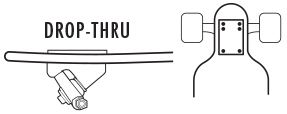 |
Drop-Thru Drop-thru truck mountings are increasingly popular with longboards and cruisers. Rather than screwing your hardware through the mounting holes to attach the trucks, drop-thru decks have cut-outs in the nose and tail so you can literally drop your trucks through it and attach on the sides. This mounting style offers more stability than a traditional top mount, but the board is less responsive |
 |
Dropped Deck In a dropped deck, the trucks are attached in traditional top mount style, but the deck itself "drops" down in the middle of the deck so only the nose and tail are raised. The low center of gravity offers stability and better slide control. The steepness of the drop varies from deck to deck. Some skateboards and longboards also use a dropped deck with a drop-thru truck mounting (this is called a Double Drop). To avoid dangerous and potentially disastrous rail bite, which is when your board comes into contact with the ground, choose a wheel diameter that will offset how low your board is. |
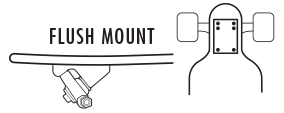 |
Flush Mount A flush mount is a good option if you want a lower center of gravity but still strong leverage over your trucks. In this style, trucks are fitted through the deck, but the top of the truck is even (or "flush") with the surface of the deck (unlike drop thrus). A deck fitted for flush mounts can only take one type of truck, meaning that riders can't change their setups once they've committed to a flush mount deck. |
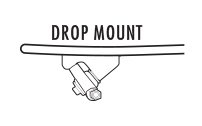 |
Drop Mount A drop mount is essentially a hybrid of top mounts and drop-thrus. In this style, trucks are fitted into the deck rather than through it, so the truck is not visible from the top of the deck. Drop mounts offer more leverage than a full drop-thru mount, but less than a top mount. |
Longboard Buyer's Guides
 DecksBuying Guide |
 Grip TapeBuying Guide |
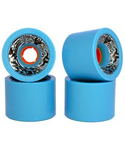 WheelsBuying Guide |
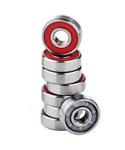 BearingsBuying Guide |
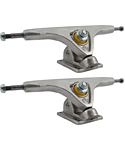 TrucksBuying Guide |
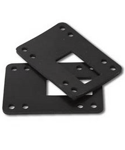 RisersBuying Guide |
 HardwareBuying Guide |
Still have questions?
We are Warehouse Skateboards. Our goal is to provide you with great customer service and information to make an informed skate purchase.
Give our customer service team a call at 877-791-9795. They will help you find the right products to fit your skateboarding needs. Still have questions? Please fill out our simple contact form.